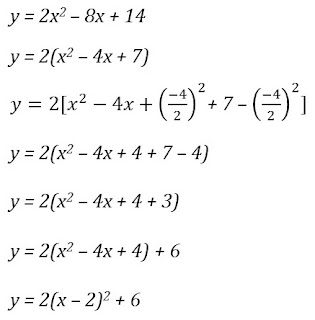
This item is taken from Cambridge International AS and A Level Mathematics (9709) Pure Mathematics 1 Paper 13 of May/June 2010.
--------------------------------------------------------------------------------------------------------------------------
To deal with this item, let us summarize the details of the problem:
(a) Syllabus area: Functions
(b) Formula/Concept needed:
> completed square form of quadratics
> discriminant (b^2 - 4ac)
> domain and range of functions
> inverse of a function
We are done with part (i) in the previous post.
For (ii), let us encircle the main concept.
This means:
To do completing the square, let us separate the trinomial into two groups. First group will be the first two terms and the second group will be the constant (last term). That means 2x^2 - 8x and 14.
Our goal is to make the first group a perfect square trinomial - meaning a trinomial whose factors equal binomials.
The first step is to get the highest common numerical factor of the first group. That is
Now, to complete the square, we will add (-4/2)^2. Note that -4 is the coefficient of the 2nd term.
Since we added (-4/2)^2 inside the first group and there is a common factor outside, the number we added is actually (2)(-4/2)^2. To balance it out, whatever we added, we will subtract it to the second group (outside the first group).
Simplify each group.
The first group now contains a perfect square trinomial. Factor it out.
*The easier way to identify the factors would be using the numbers we added without the square. That is -4/2 = -2. It means the factors will be (x - 2)(x - 2) or (x - 2)^2.
Hence, the completed square form of 2x^2 - 8x + 14 is 2(x - 2)^2 + 6 where a = 2, b = 2 and c = 6.
There is another way of completing the square. However, I would suggest you use this 2nd method if the coefficient of the 2nd term and the constant are both divisible by 2. It might be confusing for you later to deal with fractions.
[End of Part 2]
----------------------------------------------------------------------------------------------------------------------------------------------------
Your comments and suggestions are welcome here. Write them in the comment box below.
Thank you and God bless!
Thank you and God bless!






















Isn't the b = -2? due to the question asking to express the function in a(x+b)^2+c and not in a(x-b)^+c
ReplyDeleteYes, that is correct! Thank you for the correction. The answer is the completed square form anyway.
Delete